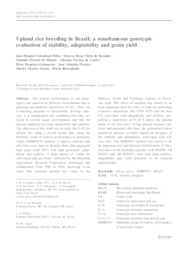Upland rice breeding in Brazil: a simultaneous genotypic evaluation of stability, adaptability and grain yield.
Upland rice breeding in Brazil: a simultaneous genotypic evaluation of stability, adaptability and grain yield.
Autoria: COLOMBARI FILHO, J. M.; RESENDE, M. D. V. de; MORAIS, O. P. de; CASTRO, A. P. de; GUIMARAES, E. P.; PEREIRA, J. A.; UTUMI, M. M.; BRESEGHELLO, F.
Resumo: The relative performance of one geno- type is not identical in different environments due to genotype-environment interaction (G 9 E). Thus, for a breeding program to successfully develop culti- vars, it is fundamental that candidate elite-lines are tested in several target environments and that the data are analysed for yield, adaptability and stability. The objective of this work was to study the G 9 E for upland rice using a mixed model and, using the harmonic mean of relative performance of genotypic values (HMRPGV) method, to analyse cultivars and elite-lines over time to identify those that aggregate high grain yield (GY) with high genotypic adapt- ability and stability. A large dataset of ??value for cultivation and use trials?? collected by the Brazilian Agricultural Research Corporation (Embrapa) and collaborators from 1984 to 2010, involving seven states that represent upland rice crops in the Midwest, North and Northeast regions of Brazil, was used. The effect of location was shown to be more important than the effect of year for promoting crossover interaction. The CNA 8555 had the best GY associated with adaptability and stability, pre- senting a superiority of 13.28 % above the general mean of all elite-lines. Using already-released cul- tivars and potential elite-lines, the generalised linear regression analysis revealed significant progress of the stability and adaptability associated with GY over time. The HMRPGV method was shown to be an important tool and allowed identification of three elite-lines in the Embrapa pipeline (AB 062008, AB 062041 and AB 062037), each with high stability, adaptability and yield potential to be released commercially.
Ano de publicação: 2013
Tipo de publicação: Artigo de periódico
Unidade: Embrapa Meio-Norte
Palavras-chave: Arroz, BLUP, G x E, Genetic progress, Genética, HMRPGV, Melhoramento genético, Melhoramento genético vegetal, Oryza Sativa, REML
Observações
1 - Por padrão são exibidas publicações dos últimos 20 anos. Para encontrar publicações mais antigas, configure o filtro ano de publicação, colocando o ano a partir do qual você deseja encontrar publicações. O filtro está na coluna da esquerda na busca acima.
2 - Para ler algumas publicações da Embrapa (apenas as que estão em formato ePub), é necessário ter, no celular ou computador, um desses softwares gratuitos. Sistemas Android: Google Play Livros; IOS: iBooks; Windows e Linux: software Calibre.
Acesse outras publicações
Acesse a Base de Dados da Pesquisa Agropecuária (BDPA) para consultar o acervo completo das bibliotecas da Embrapa.

